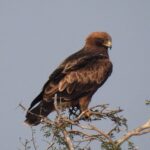Summary
Booted eagles, also known as Aquila pennata, are birds of prey found in Europe, Asia, and Africa. While they have a varied diet that includes small mammals, birds, reptiles, and insects, there is no specific evidence that booted eagles eat foxes. On the other hand, wedge-tailed eagles are known to prey on foxes as part of their carnivorous and scavenging diet.
Do Booted Eagles Eat Foxes?
 Image source: Booted eagle By Dr. Raju Kasambe
Image source: Booted eagle By Dr. Raju Kasambe
No, there is no evidence that booted eagles (Aquila pennata) eat foxes. Booted eagles are known to have a varied diet that includes small mammals, birds, reptiles, and insects, but foxes are not a documented part of their prey.
Booted eagles are a species of eagle found in Europe, Asia, and Africa. They are medium-sized birds of prey with distinctive feathered legs, giving them the appearance of wearing “boots.” These eagles are known to hunt a variety of small to medium-sized animals, but their diet does not typically include foxes.
Wedge-tailed Eagles and Foxes
While booted eagles do not eat foxes, there is evidence that another eagle species, the wedge-tailed eagle (Aquila audax), does include foxes in its diet. Wedge-tailed eagles are found in Australia and are known to be carnivorous and scavenging birds of prey.
According to research, the diet of wedge-tailed eagles consists mainly of rabbits and brown hares, but they also feed on larger mammals such as foxes, feral cats, wallabies, and small kangaroos. Wedge-tailed eagles are powerful birds capable of taking down and consuming these larger prey animals.
Differences Between Booted Eagles and Wedge-tailed Eagles
Booted eagles and wedge-tailed eagles are distinct species with some key differences:
| Characteristic | Booted Eagle | Wedge-tailed Eagle |
|---|---|---|
| Scientific Name | Aquila pennata | Aquila audax |
| Distribution | Europe, Asia, Africa | Australia |
| Size | Medium-sized | Large |
| Diet | Small mammals, birds, reptiles, insects | Rabbits, hares, foxes, feral cats, wallabies, small kangaroos |
| Hunting Behavior | Agile, perch-and-pounce | Powerful, capable of taking down larger prey |
The differences in size, distribution, and hunting behavior between these two eagle species contribute to their distinct dietary preferences. While booted eagles do not typically prey on foxes, wedge-tailed eagles are known to include them as part of their carnivorous diet.
Factors Influencing Eagle Diets
The diet of eagles can be influenced by various factors, including:
- Habitat and Prey Availability: Eagles will primarily hunt and consume the prey that is most readily available in their local environment.
- Size and Strength: Larger eagle species, like the wedge-tailed eagle, are capable of taking down and consuming larger prey, such as foxes, due to their size and physical capabilities.
- Hunting Strategies: Eagles employ different hunting strategies, with some, like the booted eagle, being more agile and adept at catching smaller prey, while others, like the wedge-tailed eagle, are better suited for taking down larger animals.
- Opportunistic Feeding: Eagles may also engage in scavenging behavior, feeding on carrion or taking advantage of other food sources that become available, which can include larger mammals like foxes.
Conclusion
In summary, while booted eagles (Aquila pennata) have a varied diet that includes small mammals, birds, reptiles, and insects, there is no evidence that they prey on foxes. On the other hand, wedge-tailed eagles (Aquila audax) are known to include foxes as part of their carnivorous and scavenging diet, along with other larger mammals. The differences in size, distribution, and hunting behavior between these two eagle species contribute to their distinct dietary preferences.
References:
- Bortolotti, G. R. (1984c). Evolution of growth rate and nestling sex ratio in Bald Eagles (Haliaeetus leucocephalus). Ph.D. thesis, Univ. of Toronto, ON.
- Buehler, D. A. (2020). Bald Eagle (Haliaeetus leucocephalus), version 1.0. In Birds of the World (A. F. Poole and F. B. Gill, Editors). Cornell Lab of Ornithology, Ithaca, NY, USA.
- McClelland, B. R., P. T. McClelland, R. E. Yates, E. L. Caton and M. E. McFadden. (1996). Fledging and migration of juvenile Bald Eagles from Glacier National Park,… Montana. Journal of Raptor Research 30:79-89.
- Wood, P. B. (1992d). Habitat use, movements, migration patterns, and survival of subadult Bald Eagles in north Florida. Ph.D. Thesis, Univ. of Florida, Gainesville.
- https://avianreport.com/baby-bald-eagles/

